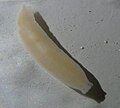 | Bipalium (redirect from Broadhead planarian) a genus of large predatory land planarians. They are often loosely called "hammerhead worms" or "broadhead planarians" because of the distinctive shape... 24 KB (2,393 words) - 14:06, 2 May 2024 |
 | Bipalium adventitium (redirect from Wandering broadhead planarian) Bipalium adventitium, the wandering broadhead planarian, is a land planarian in the subfamily Bipaliinae. It has been accidentally introduced in the United... 8 KB (789 words) - 14:57, 16 March 2024 |
 | Caenoplana coerulea (redirect from Blue Planarian) Caenoplana coerulea, known as the blue planarian or blue garden flatworm is a species of land planarian. This is a long narrow flatworm, which is shiny... 5 KB (521 words) - 15:40, 5 April 2024 |
 | Geoplanidae (redirect from Land planarians) Geoplanidae is a family of flatworms known commonly as land planarians or land flatworms. These flatworms are mainly predators of other invertebrates,... 27 KB (2,623 words) - 05:17, 29 April 2024 |
Biological immortality (section Planarian flatworms) females. Planarian flatworms have both sexually and asexually reproducing types. Studies on genus Schmidtea mediterranea suggest these planarians appear... 21 KB (2,239 words) - 13:32, 1 May 2024 |
The Lake Pedder planarian (Romankenkius pedderensis) is a species of invertebrate in the family Dugesiidae. The species is endemic to the Lake Pedder... 3 KB (206 words) - 20:51, 25 September 2023 |
Kenkia glandulosa (redirect from Pink planarian) Kenkia glandulosa, the pink planarian, is a flatworm in the family Kenkiidae. It is found only in the Devil's Icebox cave in Rock Bridge Memorial State... 2 KB (189 words) - 23:31, 8 April 2023 |
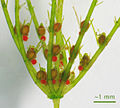 | possessing both testicles and ovaries. Each planarian transports its excretion to the other planarian, giving and receiving sperm. In most plant species... 20 KB (1,971 words) - 04:08, 21 April 2024 |
Gigantea (flatworm) (redirect from Gigantea (planarian)) Gigantea is a genus of land planarians from the Neotropical realm. Species of Gigantea have a large, broad and flat body. The copulatory apparatus has... 4 KB (289 words) - 00:12, 2 May 2024 |
 | Bipalium nobile is a land planarian of the subfamily Bipaliinae found in Japan. Bipalium nobile is a very long planarian, reaching up to 1 m (3.3 ft) in... 2 KB (185 words) - 17:16, 16 November 2023 |
 | system of planarians is broadly similar among different families, although the associated structures can vary in complexity. All planarians are hermaphrodites... 8 KB (934 words) - 00:37, 2 May 2024 |
 | Cratera (flatworm) (redirect from Cratera (planarian)) Cratera is a genus of land planarians found in South America. The genus Cratera is characterized by having a leaf-shaped body. Most species are between... 8 KB (701 words) - 00:38, 2 May 2024 |
 | He is most known for his research on learning and memory transfer in planarians conducted in the 1950s and 1960s. McConnell also published several science... 6 KB (659 words) - 05:08, 27 January 2024 |
Liana guasa (redirect from Liana (planarian)) land planarians. It is monotypic, being represented by the single species Liana guasa, which occurs in Chile. Liana was defined as land planarians with... 1 KB (115 words) - 10:19, 24 October 2023 |
 | divided into Turbellaria, which are mostly non-parasitic animals such as planarians, and three entirely parasitic groups: Cestoda, Trematoda and Monogenea;... 63 KB (6,546 words) - 01:11, 2 May 2024 |
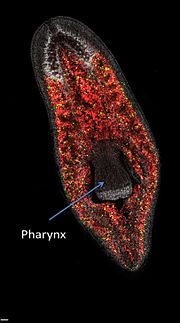 | (ˈniːəʊˌblæst) are adult stem cells found in planarian flatworms. They are the only dividing planarian cells, and they produce all cell types, including... 12 KB (1,296 words) - 18:06, 29 April 2024 |
 | Amaga (flatworm) (redirect from Amaga (planarian)) land planarians from South America. The genus Amaga was erected by Robert E. Ogren and Masaharu Kawakatsu to include Neotropical land planarians with... 5 KB (537 words) - 09:59, 4 January 2024 |
Bipalium javanum, the Javan broadhead planarian, is a species of land planarian belonging to the subfamily Bipaliinae. It is endemic to Indonesia. Like... 1 KB (151 words) - 05:27, 6 January 2024 |
 | as the shovel-headed garden worm, is a species of large predatory land planarian with a cosmopolitan distribution. It is sometimes referred to as a "hammerhead... 9 KB (971 words) - 00:37, 2 May 2024 |
 | Bipalium pennsylvanicum, the three-lined land planarian, is a species of land planarian in the subfamily Bipaliinae. They are native to Asia, but found... 3 KB (240 words) - 20:47, 4 March 2024 |
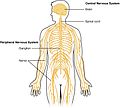 | forming forebrain, midbrain and hindbrain. Development of the neural tube Planarians, members of the phylum Platyhelminthes (flatworms), have the simplest... 34 KB (3,668 words) - 05:37, 1 May 2024 |
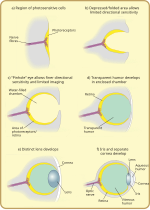 | The planarian has "cup" eyespots that can slightly distinguish light direction.... 46 KB (5,563 words) - 09:13, 2 April 2024 |
which can regenerate any part of the polyp from a small fragment, and planarian worms, which can usually regenerate both heads and tails. Both of these... 38 KB (4,419 words) - 12:54, 11 April 2024 |
 | visual indication that the limb is newly generated. The hydra and the planarian flatworm have long served as model organisms for their highly adaptive... 83 KB (9,262 words) - 05:58, 23 April 2024 |
 | These include the jellyfish Turritopsis dohrnii, the hydra, and the planarian. Unnatural causes of death include suicide and predation. Of all causes... 120 KB (12,545 words) - 08:41, 2 May 2024 |



